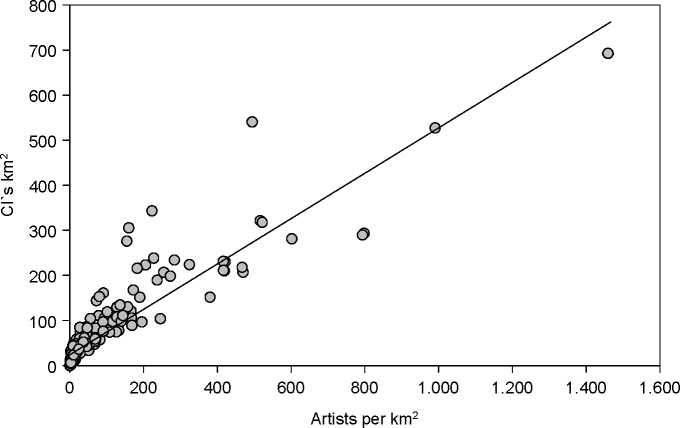insured by the ‘Künstlersozialkasse’ (artists social insurance fund), are situated,
alone, in 5 per cent of Berlin’s 190 postal code districts with a surface area proportion
of 2 per cent6. The diagrammed correlation in illustration 2 clearly shows, above the
trend line, outliers, by whom the concentration of companies is higher than that of
artists. For this section of the study, companies and small trade firms in the
industries film, radio and television, publishing, music and advertisement, software
development and multimedia, design, architecture, photography, exhibitions, fairs
and commodity market facilities as well as the supply of other cultural and
entertainment were included (approx. 24,500, from them 19,500 small trade firms;
Status: August 2005). The number of artists and employees in cultural facilities
resulted from the inventory of the ‘Künstlersozialkasse’ (approx. 23,000, Status:
August 2005). Thus, an exact classification according to postal code districts could be
conducted.
Illustration 2: Coherence between density of CIs and artists on ZIP-code areas in Berlin

Sources: Chamber of Commerce and Trade Berlin 2005; Artists social insurance fund 2005; Own
calculations.
Here it exclusively concerns postal code districts, which are located in close proximity
to the main street, ‘Kurfürstendamm’, in the Western part of the city, which belongs
to the most highly priced real estate segments7, and thereby Berlin artists, are more
than likely not considered (please refer to chapter 3.7). In former studies Mundelius
6 From these postal code districts, four are in the city district Prenzlauer Berg, two in Kreuzberg, two in
Friedrichshain and two in the city centre.
7 CB Richard Ellis Büromarktbericht 2004.
More intriguing information
1. Measuring Semantic Similarity by Latent Relational Analysis2. Industrial Cores and Peripheries in Brazil
3. Sex-gender-sexuality: how sex, gender, and sexuality constellations are constituted in secondary schools
4. Putting Globalization and Concentration in the Agri-food Sector into Context
5. Epistemology and conceptual resources for the development of learning technologies
6. Large-N and Large-T Properties of Panel Data Estimators and the Hausman Test
7. Foreign Direct Investment and Unequal Regional Economic Growth in China
8. Valuing Farm Financial Information
9. The name is absent
10. Motivations, Values and Emotions: Three Sides of the same Coin